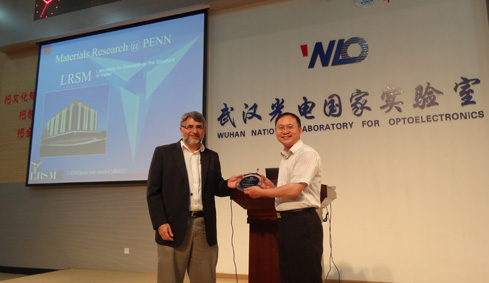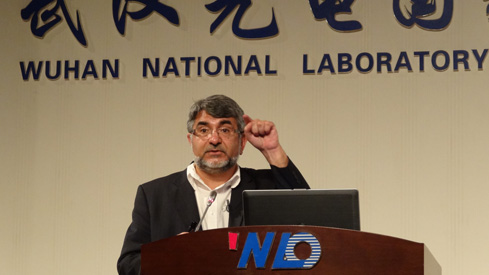WUHAN, China (September 9, 2014) - Wuhan Optoelectronics Forum No. 84 was successfully held in Auditorium A101 at Wuhan National Laboratory for Optoelectronics (WNLO) in the morning of September 9.
Functional diffuse optical imaging and spectroscopy of tissue is gaining momentum as a diagnostic in a variety of medical scenarios including breast cancer imaging, functional activation and clinical studies of brain, cancer therapy monitoring and the investigation of muscle disease. After a short introduction to diffuse optics, I will review several recent clinical studies from my lab, particularly those oriented towards breast cancer and brain function. Central to the breast cancer effort is a pilot clinical trial which has taken important steps towards quantitative assessment of diffuse optics for detection and characterization of tumors, and helps to spin-off problems such as cancer therapy monitoring. A second important application of diffuse optical methods is in the area of brain function and physiology wherein the interplay between tissue oxygen consumption, vascular supply, and regulatory effects remains poorly understood. The utility of this approach in brain will be demonstrated in several contexts, including the care of acute ischemic stroke (AIS) patients in the clinic.
Arjun G. Yodh is the James M. Skinner Professor of Science at the University of Pennsylvania, and the Director of Penn’s The Laboratory for Research on the Structure of Matter and its NSF-Materials Science Research & Engineering Center (NSF-MRSEC). His home department is Physics & Astronomy, and he holds a secondary appointment in the Department of Radiation Oncology in the Medical School. Yodh received his B.Sc. from Cornell University and his Ph.D. from Harvard University. He joined the University of Pennsylvania faculty in 1988, following a two-year postdoctoral fellowship at AT&T Bell Laboratories. His current interests span fundamental and applied questions in soft matter physics, biomedical optics, and the optical sciences. He has published more than 250 papers in these fields. Per Biomedical Optics, his laboratory carries out pre-clinical and clinical research that explores issues ranging from fundamental questions about light transport, image reconstruction and optical technology development, to identification of relevant clinical problems and application of optical methodologies to those clinical problems. Current clinical applications include functional imaging/monitoring in brain and breast, monitoring tumor hemodynamics during cancer therapy, and investigation of patients with ischemia in limbs, spine and other tissues.

